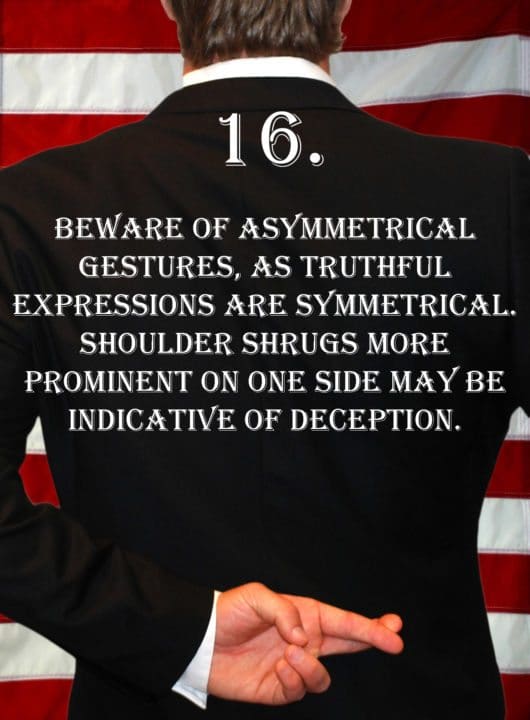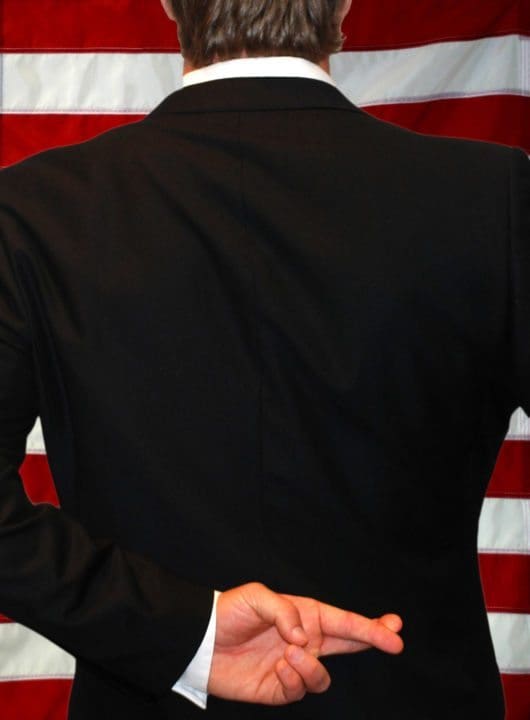
Deception Tip 16:
Beware of asymmetrical gestures, as truthful expressions are symmetrical. Shoulder shrugs more prominent on one side may be indicative of deception.
Listen To The Podcast!
E16 – Symmetrical Gestures – Deception Tips Podcast – Click Here To Subscribe
Podcast Transcript
Hello, and welcome to the Deception Tips Podcast, where you will learn amazing cues to detect deceit that will help you read people like never before. I’m your host, Spencer Coffman. Let’s get started.
Here we are once again- another episode of the Deception Tips Podcast. This is episode 16. Thank you for tuning in. Last time, we talked about something that is a great tool for you to use when you’re trying to determine whether or not someone is telling a fictional story or whether it is a truthful story. We’ve said that liars, often rehearse their stories in order of course!
They tell their stories in the sequence of events that happened. They rehearse them one thing to the next. ‘First, I did this, then I did this, then I went here, and then this happened.’
However, if you want to trip them up, you can ask them to tell that story in reverse because oftentimes, they do not rehearse their stories in reverse. And, because it’s not a real memory, they don’t remember what happened so they are unable to tell it in reverse.
If it is a true story, they’ll easily be able to recall the series of events that happened and they can tell them to you backward because they’ve recorded those in their brain. It’s something that actually happened to them, so they’ll be able to tell that story to you in reverse events. It wasn’t something they memorized.
This is a great example right here: Say the alphabet backward for me. How far can you get? Try it out. Z, Y, X, then what? W. It’s tough! Why? Because you’ve memorized the alphabet from A, B, C, and so on. You haven’t taken the time to memorize it backward.
It wasn’t an event that happened to you or that you were a part of. It was something that you memorized and you memorized it in a specific order. You memorized A, B, C, D, and so on. You didn’t memorize Z, Y, X, and so on. You memorized A, B, and C. This is the same with liars. When they rehearse a lie, they’re memorizing A, B, and C, so they don’t remember Z, Y, X, and so on because it never happened.
However, if it did truly happen, like that watermelon story we talked about, you can easily recall the events. “Oh. Tell it to me backward.” “Well, I left the store, I bought the watermelon, I dropped the watermelon on the floor,” and so on.
You can tell things backward if they really happened to you. So, this is a really great tool that you can use. Pull it out of your toolbox when someone’s giving you a narrative story that you think maybe fictional.
Be prepared for a little bit of resistance because it is one of those pseudoscience questions. Such as, “If I say something, you say the first thing that comes to mind. Furniture. Clothing. Color. Shape.” Etcetera. People don’t really like those kinds of things because they don’t believe they work.
However, in certain situations, they can work. So, when the situation presents itself. Ask people to tell their story in reverse and see what happens. If you’re met with resistance, but they can tell the story, don’t worry about it. Move on. Continue your questioning and go from there.
Today, we are going to talk about another sign of deception that we’ve kind of already talked about. It is a popular sign and it is one that is so very, very important when it comes to telling whether or not people are telling the truth.
Today we are going to talk about symmetricality in gestures. Now, we already talked about symmetricality in facial expressions a couple of weeks ago when we talked about symmetrical expressions and smiles. And we mentioned that the right brain is more popular when it comes to false emotions which means that the symmetricality is displayed on the left side of the face.
We also talked about, in episode 12, simultaneous gestures. The gestures have to occur with the speech. So, when people are pointing and talking at the same time. We brought up Bill Clinton and his Monica Lewinsky scandal and Richard Nixon and the “I am not a crook” scandal. And, we also talked about my karate-chopping guy Kasich in the presidential debates and how his gestures were always right on with what he was saying. So, those things happen.
Today, we are going to talk about symmetrical gestures and truthful expressions happening at the same time. So, here it is. Deception Tip 16: Beware of asymmetrical gestures as truthful expressions are symmetrical. Shoulder shrugs more prominent on one side may be indicative of deception.
Here it is again. Beware of asymmetrical gestures as truthful expressions are symmetrical. Shoulder shrugs more prominent on one side may be indicative of deception.
I mentioned this a few times ago with the shoulder shrugging. Oftentimes people who shrug with one shoulder are not really feeling that emotion. That it’s more of a lie. It’s a deceptive emotion.
Usually, when you see things that are truthful, they are symmetrical. They shrug with both shoulders. They turn both palms upwards. They raise both their palms. They may dip their head down but, as I mentioned, their head isn’t going to go to both sides because we only have one head. So, that’s not going to be symmetrical.
However, oftentimes, the behaviors will be symmetrical with one another and so will the gestures that happen with speech. We’ve talked about this many times when we said physical tasks way back in episode 4. Physical tasks happen congruently with the person talking.
So, for most people, if they can talk and do something at the same time or if they can walk and chew gum at the same time, they’ll be able to do an easy physical task while telling their story, or while talking. They can put the coffee grounds in the filter, in the pot, pour the water, etcetera, while they’re continually telling their story.
Also, their gestures will be simultaneous with their speech. When we said that when they point and say things that it will go. When they say, “You!” Their finger will go out immediately when they’re saying ‘you.’ Or when they’re saying “That one over there!” Their finger goes right over there. It’s not, “You!” and then their finger goes. It’s, “That one!” and their finger goes. No. It’s at the same time.
Same thing with when people are laughing and they smack the table, or they smack their leg, or their knee, or whatever. Or when people are emphasizing points in a business meeting or in some other conversation and their finger is hitting the desk and they say, “This- is-the-last-straw!” and every time they’re hitting the desk. “This *tap* is *tap* the last *tap* straw *tap*!” So that happens symmetrically with what they’re saying.
In addition, they also have symmetrical expressions. So, these emotions would be shown on both sides of their face, simultaneously and also symmetrically. And today, the gestures are something we’re going to talk about where, not the face, but actually the gestures, the body language, will be symmetrical.
So, I’m going to break it all down for you. We’ll talk about each of these things. I’ll even bring back the other things that we talked about so that we can kind of get a good idea of all the different symmetricality gestures and symmetricality expressions that we’ve talked about. And I’m going to do it right after this.
How would you like to stay sharp when it comes to reading people? Get the Deception Tips emails delivered to your inbox each week. Sign up today on spencercoffman.com.
Okay, so, when we look back we’ve got the physical tasks. Physical tasks happen where they’re performing some action and telling the story. So, that is a sign of body language, gestures, or actions that they are physically doing and speech pattern. So, we have speech and action.
The speech and the action should be happening at the same time. We’ve talked about examples, we’ve gone over them. If you don’t remember them, take a look at episode 4 physical tasks, and we’ll go over it all again there. So, I encourage you to listen to that.
Then, we’ve talked about simultaneous gestures. Now, this means that gestures will happen simultaneously with what people are talking about. So, when they point or when they say ‘you,’ or when they’re tapping on the desk, the gesture happens congruently with what they are saying. So, that is again, speech patterns and physical gestures.
However, instead of a physical task, this gesture is directly emphasizing the speech. So, they happen EXACTLY at the same time. They are very congruent and very simultaneous. It doesn’t get any more simultaneous by definition. It happens at the same time. So, pay attention to that. They happen together. If they don’t, there is a lie there. So, these are speech patterns and a gesture. It’s reinforcing.
Then, we’ve talked about symmetrical expressions. So, this means that the emotional expressions that happen, primarily on the face we’re talking about, happen at the same time. This is episode 14 by the way- Symmetrical Expressions. Simultaneous Gestures was episode 12. So, you can check back on both of these if you need any refreshers, or have any questions or anything like that.
But symmetrical expressions are on the face. These are emotions that are expressed. Things like surprise. Oftentimes, both eyebrows go up. Both eyes expand a little bit or eyelids go up a little bit so you can see more of the whites of the eyes and underneath the sclera. And also, their mouth drops open. So, both sides of their mouth open equally, not just one side or the other.
And smiles are a big one. When people smile people have a genuine expression of enjoyment or smile, they will smile on both sides of their face. You’ll see the crow’s feet wrinkles under both corners of the eyes. You’ll see the cheek muscle go up and the little dimples happen on both sides. You’ll see both corners of the mouth going up and you’ll see the bottom lip going down and away in both directions equally.
However, if it doesn’t happen together- this is the case with any of these- if they ever don’t have a symmetrical facial expression of emotion, if ever the reinforcing of their gesture to their speech is off.
So, they say ‘you’ and then point- or if ever their gestures are not happening simultaneously- like we said ‘you’ and then point or if they aren’t doing the physical task when talking- this all comes from the right side of the brain. So, it’s more likely to happen on the left side of the body.
Now, this isn’t always the case with gestures. For example, if it was then we would say anytime someone uses their left hand with a gesture and it doesn’t match up then it’s lying, but if they use their right hand that’s usually going to be a truthful gesture and it’s going to match up.
That’s not the case because someone who is right-handed may only use their right hand in speaking and someone who is left-handed may only use their left hand in speaking or pointing. So, that will not be the case.
However, it is most definitely the case with facial expressions. So, when you see a smile more predominant on the left side of the face, that means that it is most likely a fake smile. That is because the right brain, or the right cerebral hemisphere, is so much more active in deception.
So today, when we talk about asymmetrical gestures, we’re not talking about gestures and speech or something that’s happening congruently together. Just like how we had simultaneous gestures that were gestures and speech.
Then we had symmetrical expressions that are only facial expressions. Now we have symmetrical gestures. So, these are gestures only. We had gestures and speech, then we had facial expressions only, now we have body only.
So, these gestures will be things you see on the body only. Things like shoulder shrugs. If someone shrugs with both shoulders, that’s symmetrical. If they shrug with one shoulder, that’s asymmetrical. That’s usually deceptive or they really don’t know. Oftentimes, you’ll see this when someone is making a statement. This happens all the time with big business CEOs.
You’ll see a big CEO saying, “Oh! Our stock prices are really great!” and as they say that, one shoulder may shrug. That means they have absolutely no confidence in what they’re saying. They say, “Oh! Our stock prices are really great. They’re going to go up.”
And as they say that they may turn up one hand or their shoulder will shrug- Boom! They have no confidence in what they’re saying. They know that their stock is going to plummet. Beware. You’ll see it all the time when people are making statements like that. It’ll be an asymmetrical shrug.
In addition, they may do things like speaking. When people put their hands in front of them and are talking, usually with their hands- they’ll have their fingers all spread out and they’re using them to emphasize and they may spin them in circles like the old tae-bo where they do their hands in a circle, or a dancing type of thing they have their fingers extended- and they’re using that to kind of show this ‘on-and-on’ type of a gesture.
Or their hands go up above their shoulders above their forearms and they move them side to side like an accordion with fingers spread out. Oftentimes, they do it with both hands. Both hands are out in front of them. Both hands are moving back and forth.
They’re doing the gestures. Both hands look symmetrical because they have the same shape. Their fingers are extended. Maybe they’re a little bent kind of like they’re going to grab onto something or turn a doorknob.
But, if you see where one hand is out there doing that and the other one is maybe fixed like a karate chop kind of a hand, now they’re not symmetrical. Now you know something’s going on.
But, of course, maybe they had a stroke on one side, so they can’t open their hand. You never know what the outlying circumstances could be. So, this is why you look for patterns of behaviors and clusters which is why, with this, we have so many different kinds.
You can look for symmetricality in the physical things that they do, you can look for symmetricality in their facial expressions, and you can look for symmetricality in their gestures. Oftentimes, gestures will be symmetrical exactly like facial expressions. So, when someone does a gesture, it’s going to happen with both sides of their body: not always, but most of the time. This is just like everything else: not always, but most of the time.
But, if you can pay attention to this and you can notice when people do one-sided shoulder shrugs, or when they turn on hand up kind of like ‘meh’- then you’ll know that those are not genuine feelings of emotion or truth.
There is something else going on there. There is some form of deception. Pair it up with other signs of leakage, other signs of facial expression. Form a cluster and a pattern of behaviors. Then you will be able to know if that person is telling the truth.
I want to thank you for listening to this week’s episode of the Deception Tips Podcast. I encourage you to share it with your friends, subscribe to the feeds, check out the Deception Tips blog, take a look at my books and tune in every week for a new Deception Tip.
Video Transcript
Hey guys, my name is Spencer Coffman. Thank you for watching the Deception Tips videos, they’re all about teaching you how to read people and detect deception so that you will know if someone is lying to you.
Today we are going to continue on a long-term pattern that we’ve hit up several times before and we’re going to continue it throughout all of these videos. It’s something called symmetricality. They need to be uniform. Gestures, expressions, speech, and gestures all need to be happening congruently, symmetrically, and in unison. We’ve talked about facial expressions being symmetrical on both sides of the face, we’ve talked about gestures and speech matching up and being symmetrical, and we’ve talked about patterns and other things happening congruently and simultaneously with each other.
Today we are going to talk about gestures being symmetrical, which means on both sides of the body. So you’ll notice in a lot of these videos I have been using my hands as a part of my speech. When I talk, my hands move with my voice, and they happen together. Often times, both hands move together. It’s never I move this hand and this hand like this unless I say one then the other. But in that circumstance, it’s happening one then the other with my speech.
So they’re congruent and simultaneous in that respect, even though the hands move not with each other. Today, we’re going to focus only on the body aspect, and it’s going to be how both sides of the body must happen at the same time. Both movements on both sides need to happen symmetrically.
So here it is, Deception Tip 16: “Beware of asymmetrical gestures, as truthful expressions are symmetrical. Shoulder shrugs more prominent on one side may be indicative of deception.”
Now, this is very important. I said shoulder shrugs are in there. Typically, shrugging of the shoulders is something that happens on both sides, and it’s usually like a gesture that comes about when someone doesn’t know something when they are trying to convey innocence or ignorance or stupidity or something like that. They may say, “I don’t know,” and both of the shoulders go up.
However, you’ll see it, and sometimes you can, you can see this on TV a lot, and in addition, if you interact with teenagers or kids on a regular basis, you’ll see it in their body language quite often. Or if you’re interacting with suits, business people, you may see it there because it’s usually a one-sided shoulder-shrug. Kind of like, “well, I would do that, but something else came up,” or something like that. Or they say, “yeah, this is great,” and one shoulder goes up, not the other. It’s one or the other. It’s asymmetrical.
That typically means that they are being deceptive. Either they have no idea what’s really going on, or they have some kind of hidden idea what’s going on. Usually, it may mean something like they have no confidence in what they’re saying. It’s kind of like a halfway, halfway committed type of a thing. Usually, if someone is into something, they’re going to be, as we’ve talked about in prior videos, they’re going to be leaning in, they’re going to be forward, they’re going to be engaged. Whereas if there’s a one-sided shoulder shrug, that’s kind of like, well, take it or leave it. I’m half in, I’m half out.
Typically, also this will be seen with… you may see like one hand if it’s usually down by the waist, where they make kind of turn one hand up and one palm goes up and not the other, kind of like a whatever type of a deal, that’s a one-sided gesture. It’s on half of the body. Now, based on our right brain left brain stuff that we’ve talked about before, this would typically happen on one side of the body more than the other, but it’s not always going to be the case.
The reason is because different people may be right brain or left brain dominant, however, usually the right brain is more in false emotion, so it would typically happen on the left side of the face, but again, depending on the dominance, or whether someone is right-handed or left-handed, or whether they are more spacious, or spacial intelligence compared to linguistic intelligence, that that could all be a little bit changing, which is why it is essential to look for patterns and clusters of behavior.
Because if you see asymmetrical gestures, where they happen on one side of the body, then typically you’re going to see that their speech did not match that gesture, So that will be incongruent and asymmetrical as well. You may also see some asymmetrical facial expressions. In addition, you may see noncongruent behaviors happening with that in addition to all of those other signs. So, asymmetricallity is something to watch out for in multiple areas.
Watch for it on the face, the body, speech, speech with the body, face with the body, etc., because it will happen all over. In addition to many other signs of deception that will happen as well. All the other ones that we’ve talked about, different patterns, and different clusters of behavior. There will always be more than one sign as long as they are continuing to lie.
So if this is your first time watching these videos, I would love to have you subscribe to the channel on YouTube. Feel free to leave any comments with questions on there as well. Also, if you would like more information, we’ve got books, podcasts, blog posts all available on SpencerCoffman.com that are dedicated to teaching you what every body is really saying.
Until next time.






